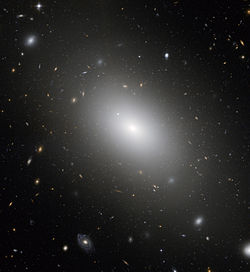| NGC 1132 | |
|---|---|
 A visible light image of NGS1132 with X-ray emission superimposed (rendered in blue) | |
| Observation data (J2000 epoch) | |
| Constellation | Eridanus |
| Right ascension | 02h 52m 51.82s [1] |
| Declination | −01° 16′ 29.0″ [1] |
| Redshift | 6871 km/s [2] |
| Heliocentric radial velocity | 0.023189 [2] |
| Distance | 263.9 Mly (80.91 Mpc) [3] |
| Apparent magnitude (B) | 13.9 [2] |
| Characteristics | |
| Type | E [2] |
| Other designations | |
| UGC 2359, MCG +00-08-040, PGC 10891 [2] | |
NGC 1132 is an elliptical galaxy located in the constellation Eridanus. [4] The galaxy was discovered by John Herschel on November 23, 1827. [5] It is located at a distance of about 318 million light-years away from Earth. [6]
NGC 1132 and nearby small galaxies are known as a "fossil group" that resulted from the merger of a group of galaxies. [4] It is the prototype example of the class of fossil galaxy groups. [7] The identification as a fossil group was made in 1999. [8] This group contains an enormous amount of dark matter and a large amount of hot gas that emits X-ray radiation. [9] The galaxy is surrounded by thousands of globular star clusters. [10]
One supernova has been observed in NGC 1132: SN 2024pbe (type Ia, mag. 17.8). [11]
